Peace
Timeline: 1999
Pre-1999
| 2000
| 2001 | 2002
January
7, 1999
| Formal peace talks begin between the
government and FARC. "Tirofijo," however, fails to appear
at the opening ceremony, leaving President Pastrana seated alone
at the table. The FARC claims that the snub was unintended, citing
concerns about a threat to assassinate the guerrilla leader. |
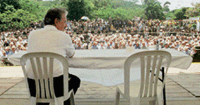
Photo from Semana magazine
|
January
8, 1999
 |
The morning after the opening ceremony,
"Tirofijo" (right) and number-two FARC commander Jorge
Briceño ("Mono Jojoy," left) appear just outside San Vicente.
They repeat their claim that security concerns kept the FARC leader
from attending the previous day's event. |
January
7-13, 1999
Ending a twelve-day
Christmas cease-fire, the paramilitary United Self-Defense Forces of
Colombia (AUC) go on a brutal killing spree in several areas, murdering
at least 160 people, all of them civilians. The rampage is apparently
revenge for a FARC attack on the AUC headquarters and a nearby town
on December 28, while the paramilitary group was observing its cease-fire.
January
11, 1999
Briceño threatens
to begin kidnapping congresspeople and other politicians if the government
refuses to accept its proposal for a prisoner exchange. Pastrana responds
that the peace process will end immediately if the FARC carries out
Briceño's threat.
January
19, 1999
Citing the upsurge
in paramilitary activity, the FARC "freezes" the peace dialogue
until April 20. Talks will not continue, a guerrilla communiqué states,
until the government acts against paramilitary groups and government
and military officials believed to be linked to the right-wing militias.
January
28, 1999
Four employees of
the Popular Training Institute (IPC), a Medellín-based non-governmental
human rights organization, are kidnapped by the paramilitary United
Self-Defense Forces of Colombia (AUC), led by Carlos Castaño. Two members
of the Committee in Solidarity with Political Prisoners (CSPP) are killed
by suspected paramilitaries on January 30. On February 1, Castaño issues
a communiqué threatening the lives of human-rights workers. The four
IPC employees are released within two weeks.
February
6, 1999
Though talks with
the FARC remain frozen, the Pastrana government announces a 90-day extension
of the guerrilla group's demilitarized zone in southern Colombia. The
"clearance" is now to expire on May 7.
February
7, 1999
Citing the threat
of incursions from Colombian guerrillas, Peru deploys thousands of troops
to its 1,000-mile border with Colombia. The action comes four days after
Peruvian President Alberto Fujimori gave a speech in Washington warning
about the guerrilla threat and criticizing the Pastrana government's
peace strategy.
February
10, 1999
Secret peace discussions
begin in Caracas, Venezuela between representatives of the National
Liberation Army (ELN) and government Peace Commissioner Víctor G. Ricardo.
ELN leaders Antonio García (the group’s "number two"
leader), Pablo Beltrán and Milton Hernández issue a previously un-voiced
demand for a demilitarized zone, similar to that granted to the FARC.
The guerrillas hope to clear security forces from four municipalities
of southern Bolívar department. In this area, the ELN leaders say they
will host a several month-long "convention" with government
and civil society representatives to develop an agenda for peace negotiations.
February
16, 1999
The ELN breaks off
talks after the government refuses to grant the smaller guerrilla group
its own demilitarized zone.
February
18, 1999
President Pastrana
hosts a day-long meeting with civil society and opposition leaders in
a first attempt to forge a broad-based "political agreement"
on peace policy. The preliminary meeting, which yields few commitments,
is a response to criticism that Pastrana's administration is leaving
all other actors out of its peace effort.
February
25 - March 11, 1999
Three U.S. indigenous-rights
activists, Terence Freitas, Lahe'ena'e Gay, and Ingrid Washinawatok,
are abducted February 25 by FARC guerrillas in the northeastern state
of Arauca. Their bodies are found on March 6. The three activists had
been working with the U'wa, an indigenous ethnic group in the region.
After conducting its own investigation, the FARC admits responsibility
for the murders on March 11, asking forgiveness and blaming the act
on a low-ranking field commander in the area.
The Colombian government
alleges that higher-ranking FARC commanders ordered the killings, including
the chief of one of the fronts operating in the area, Germán Briceño
("Grannobles"), the brother of number-two FARC leader Jorge
Briceño. The U.S. State Department announces that it will not meet again
with FARC representatives, as it did in December 1998, unless the FARC
turns those responsible for the crime over to Colombian authorities.
March
23-25, 1999
U.S. and Colombian
defense officials gather in Colombia for the first meeting of the military-to-military
Bilateral Working Group between the two countries. The meeting, described
as cordial and productive, divided into three working groups: general
policy, counterdrug, and force modernization and professionalization.
March
25, 1999
The United Self-Defense
Forces paramilitary group issue a threat in the northern region of Urabá,
warning all international human-rights workers to leave Colombia. The
communiqué also threatens the safety of non-governmental organizations
and "peace communities" -- groups of citizens refusing to
deal with any party in the conflict -- in Urabá.
April
9, 1999
| President Pastrana forces the retirement
of two senior Army generals, Gen. Rito Alejo del Río (left), the
Army's chief of operations, and Gen. Fernando Millán (right), head
of the Army's war college. Both were widely accused of assisting
paramilitary groups. While human rights and peace activists applaud
the move, many in Colombia see the resignations as either a concession
to the FARC, which had called for high-profile resignations of officers
linked to paramilitaries, or as a concession to the United States,
whose Assistant Secretary of State for Human Rights, Harold Koh,
was to arrive in Bogotá that same day. |
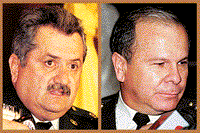
from El Espectador
|
April
9-12, 1999
Koh visits Colombia
to attend a U.S.-sponsored conference in Medellín on peace and human
rights. Koh makes several direct statements at the conference and in the press, particularly with regard to
continued linkages between military personnel and paramilitary groups.
April
12, 1999
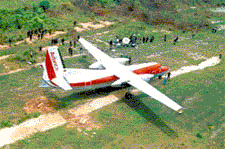
Photo from Cambio magazine
|
ELN fighters hijack an Avianca Airlines
flight bound from Bucaramanga to Bogotá, forcing it to land and
kidnapping all passengers and crew. While a few passengers are released,
most remain hostages. Some analysts see the kidnapping as an attempt
by the ELN -- which is seen as a much weaker guerrilla group than
the FARC -- to show strength and thereby extract greater concessions
from the government in eventual talks. |
April
20 - May 1, 1999
Unofficial talks
between government and FARC representatives begin in the southern demilitarized
zone. FARC leaders say the talks are still officially "frozen"
while it evaluates the government's efforts against paramilitary groups.
Pushing for an expansion of the "clearance zone" in order
to enact a cocaine crop substitution program, FARC officials say that
they will end all peace talks if the government does not at least push
back the zone's May 7 expiration date.
April
27, 1999
The government rejects
an ELN demand for a small demilitarized zone in exchange for the release
of the Avianca hostages.
May
2, 1999
| President Pastrana visits FARC rebels
in the "clearance zone" for the second time since becoming
president. Pastrana meets with FARC leader Marulanda for six hours,
convincing him to agree to formal peace talks with the government
starting May 6th. In a statement released by Pastrana, the president
indicates the "unwavering political commitment of both sides
to find a political solution to the conflict." Although the
size of the clearance zone is not expanded, its expiration date
is postponed. The two leaders also agree to form an international
verification commission that will verify agreements and monitor
FARC actions in the zone. |
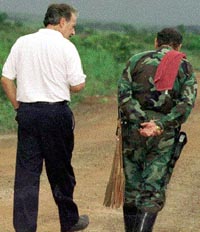
Photo from Semana magazine
|
May
6, 1999
FARC and government
officials meet and agree on a joint agenda for formal negotiations, a
stage that past talks with the FARC were unable to reach. The formal
talks are to begin in approximately three weeks.
May
21, 1999
The United Self-Defense
Forces of Colombia (AUC), the powerful paramilitary group led by Carlos
Castaño, kidnaps Liberal Party Senator Piedad Córdoba, the head of the
Senate's human rights committee. The AUC demands to be treated as a
political actor and to enter into peace talks with the government. Pastrana,
arguing that kidnapping is no way to gain political legitimacy, refuses
to submit to what he considers AUC blackmail. Córdoba is released on
June 4.
May
26, 1999
|
The respected Minister of Defense, Rodrigo Lloreda, abruptly
resigns, citing disagreements over the peace process with the
FARC. Lloreda protested statements made on May 21 by government
Peace Commissioner Víctor G. Ricardo indicating that the "clearance
zone" might be extended indefinitely. The defense minister
also cited Pastrana's failure to return a phone call inquiring
about Ricardo's statements.
Lloreda's resignation
is accompanied by the alarming resignations of at least fifty
other high-ranking officers, including eighteen generals. While
President Pastrana accepts Lloreda's resignation, he refuses
to accept the others. The head of the armed forces, Gen. Fernando
Tapias, offers Pastrana a public show of support.
Luis Fernando Ramírez
is named as the new defense minister.
|
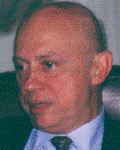
Photo from Semana magazine
|
May
29, 1999
ELN guerillas kidnap
143 churchgoers from La María Cathedral in Calí. The group releases
83 hostages immediately and proceeds to release smaller groups over
the next few weeks, eventually for holding only the wealthiest
May
31 - June 4, 1999
|

CIP President Robert White
with Comandante Jairo of the FARC (from El Espectador)
|
The Center for International Policy leads a delegation from the U.S. Congress to Colombia. Rep. William Delahunt
(D-MA) and staff members for six other members of Congress meet with
government officials and representatives of political parties, church
groups, peace groups, human rights groups, the U.S. government, and
the United Nations.
On June 4, the delegation, accompanied by Colombian government
Peace Commissioner Víctor G. Ricardo, travels to the clearance zone
for a meeting with FARC comandante Raúl Reyes. The U.S. delegation
raises concerns about the FARC's willingness to seek a political
solution, its links to the drug trade, and kidnappings and murders
of U.S. citizens.
|
June
20, 1999
The government announces
that the formal negotiations with the FARC will begin on July 7th.
July
6, 1999
The government and
FARC postpone peace talks until the 19th of July. The reasons given
for the postponement are (1) the inability of three members of the FARC
negotiating team to arrive at the clearance zone on time, and (2) the
need for more time to define "the rules of the game" for the
international commission -- a result of the May 2 agreement between
Pastrana and Marulanda -- that will verify conditions in the clearance
zone.
July
8-12
The FARC launches
a five-day offensive throughout Colombia which one army official calls
"the largest and most demented guerilla offensive in the past forty
years." The campaign encompasses 15 towns, one of which is just
35 miles south of Bogotá. The guerillas bomb banks, blow up bridges
and energy infrastructure, block roads and assault police barracks.
The Colombian military successfully counters the offensive, thanks in
part to U.S. intelligence monitoring which enables government aircraft
to bomb FARC transports en route to their target areas. Government reports
claim that upwards of 300 combatants lose their lives in the fighting,
over 200 of them FARC guerillas. The FARC accuses the government of
exaggerating FARC losses.
July
15, 1999
On a visit to Washington,
Minister of Defense Luis Ramirez and Armed Forces Chief of Staff Gen.
Fernando Tapias request $500 million in counter-narcotics and counter-insurgency
assistance for the next two years.
July
16, 1999
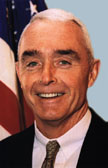
From ONDCP web page
|
U.S. "Drug Czar"
Barry McCaffrey proposes one billion dollars in "emergency
drug supplemental assistance" for fighting the drug war in
South America. The suggested assistance includes $570 million in
aid for Colombia, most of it for Colombia's security forces. McCaffrey
also suggests that differentiating between anti-drug and anti-insurgency
efforts is counterproductive, indicating that the two are interdependent. |
July
19, 1999
Citing an inability
to agree upon the creation of an international verification commission,
FARC-government talks are suspend until July 30th. FARC spokesman Raúl
Reyes argues that Colombia's military is exaggerating the threat posed
by the FARC in order to obtain foreign aid.
July
26, 1999
U.S. "Drug
Czar" McCaffrey visits Pastrana and other Colombian officials in
a four-day visit to South America. McCaffrey again stresses his support
for increasing military aid to the area and suggests that the U.S. should
"reevaluate" its policy toward Colombia.
July
30 - August 1, 1999
The AP calls a FARC
attack on the town of Nariño, Antioquia "one of the most deadly
guerrilla assaults on civilians in memory." The attack is conducted
by 300 guerrillas against a police station guarded by 35 police officers.
The guerrillas' use of inaccurately launched bombs made from gas canisters
destroys the downtown area and kills seventeen people, including eight
civilians, four of them children.
August
5, 1999
The government opens
the possibility of peace talks with the ELN by convening a small group
of government and civil society negotiators that will work towards the
release of ELN hostages and perhaps begin to pursue a dialogue on peace.
August
8-9, 1999
Amid diminishing
support in Washington for the peace process in Colombia, Under Secretary
of State Thomas Pickering visits Colombia on a trip aimed at gaining
a clearer vision of the Colombian government's peace strategy. Pickering,
the highest ranking U.S. official to visit Colombia in years, affirms
U.S. support for the Pastrana government and the beleaguered peace process.
Pickering reportedly also advised Pastrana not to make further concessions
to the FARC, and asked the Colombian government to orient future U.S.
assistance by drafting a plan explaining its peace, development and
counter-drug strategy.
August
10, 1999
| The National Judicature Council, a
body that resolves jurisdictional disputes between military and
civilian courts, ruled by a 4-3 vote that Gen. Jaime Humberto Uscátegui
will stand trial in a military court. Uscátegui, the army's regional
commander during a week-long paramilitary massacre of about thirty
people in Mapiripán, Meta in 1997, stood accused of dereliction
of duty for ignoring calls to stop the killings. The case against
him made Uscátegui the highest-ranking active military officer ever
arrested for a human rights-related crime. Human rights groups,
charging that the military court system is systematically lenient,
viewed the National Judicature Council's decision as a serious setback. |
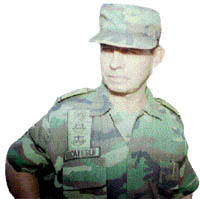
Photo from Semana magazine.
|
September
2, 1999
President Pastrana
fires General Alberto Bravo Silva, commander of the army's Fifth Brigade,
for failing to stop a paramilitary massacre of thirty-six people in
the Catatumbo region of northeastern Colombia on August 20 and 21. Bravo
had dismissed months of warnings that the paramilitary rampage was imminent.
September
20-22, 1999
President Pastrana
visits New York and Washington to promote the "Plan Colombia,"
a $7.5 billion proposal to end the conflict, curb narcotrafficking,
and revive Colombia's economy. Of this total -- which includes $4 billion
in police and military assistance -- Pastrana seeks $3.5 billion from
donor countries, especially the United States. U.S. officials promise
support for the "plan," but make no specific commitments.
October
24, 1999
Between 6 and 12
million Colombians mobilize in the streets to demand an end to the fighting.
Several Colombian peace and human rights groups, among them País Libre,
Redepaz and Viva la Ciudadanía, organized this nationwide protest against
kidnappings and the armed conflict.
This same date also
witnessed a re-starting of talks between the FARC and the Colombian
government.
November
14, 1999
A FARC offensive
-- believed to be a response to President Pastrana's call for a holiday
cease-fire -- deals the peace process another setback. The Colombian
armed forces turn back a FARC attempt to take Puerto Inírida, the capital
of remote Guainía department.
November
19, 1999
The U.S. Congress
adjourns without approving a widely expected military, police and economic
aid package in support of the "Plan Colombia." Most analysts
expect Congress to consider a supplemental aid proposal soon after it
reconvenes in January.
December
5, 1999
FARC leaders and
Colombian government officials hold a televised meeting at Los Pozos,
Meta, asking the Colombian people for suggestions or questions via e-mail,
fax and phone. The event, however, is plagued by technical difficulties
which prevent many Colombians from viewing it or contacting the participants.
December
9-20, 1999
The FARC carries
out another offensive, with combat occurring in seven different departments.
The greatest casualties result from a FARC attack on a naval post in
Juradó, Chocó, near the border with Panama, and from a military aerial
attack on FARC fighters outside Hobo, Huila.
On December 20,
the FARC announces a holiday cease-fire, calling off military operations
until January 10, 2000. Peace talks are to resume on January 13.
Pre-1999
| 2000 | 2001 | 2002
See
also:
"An Overview of Recent Colombian History,"
from the Colombia Human Rights Network website.
"Colombia: A
Country Study" - US Library of Congress
State Department
Background Notes: Colombia
CIA World Factbook
1998: Colombia
CIP's New and Noteworthy
Page, including links to current Colombia news
|

